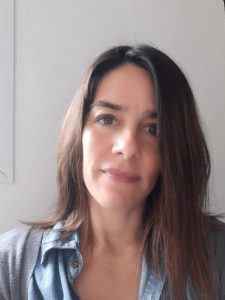Salomone, Vanesa Natalia

Associate Researcher CONICET
Lecturer (part-time) - ECyT, UNSAM.
https://orcid.org/0000-0001-8629-8132
https://www.researchgate.net/profile/Vanesa_Salomone
Professional resume + Expertise
Vanesa Salomone has a degree in Biology and a PhD in Chemistry, both from the UBA. She entered the Institute of Research and Environmental Engineering (IIIA-UNSAM-CONICET) in 2014, as a postdoctoral fellow and since 2016 she is a CONICET researcher. She also teaches at the UNSAM School of Science and Technology since 2011.
Dr Salomone's research area is related to the monitoring of aquatic and urban environments, about the presence of different contaminants present in water, and their effect on different living beings, including man. In aquatic environments, the environmental role of certain organisms, such as algae, is analysed. This involves the study of bioaccumulation processes of pollutants and their application as biomonitors or in remediation. Besides, the possible risks to humans from direct or indirect consumption of these organisms are considered. In urban environments, my work focuses on the analysis of different contaminants in water (of biological, industrial, domestic origin, etc.) and their impact on human health.
Keywords
aquatic pollutants, water quality, algae, arsenic.
Research
There are about 150 species of marine macroalgae harvested around the world and used mainly in the food industry. Seaweeds are considered a food of high nutritional value, is rich in macro and micronutrients, have high protein and vitamin content and are an important source of unsaturated fatty acids and fibre. In addition, they have industrial, agricultural, pharmacological and environmental uses. An important characteristic is that they are capable of accumulating non-essential elements (in concentrations much higher than those found in the environment), some of which are highly toxic, such as arsenic, lead, mercury, chromium, among others.
Results obtained by our working group on two species of Patagonian macroalgae showed high values of arsenic. However, the toxicity and physiological behaviour of this element depend on both its chemical form and its state of oxidation. Inorganic species of As are more toxic than organic species (mostly methylated compounds and arsenosugars), and As(III) is more toxic than As(V). There are regulations for metals in seaweed products used as additives, but there are no regulations for limits in raw algae, with some exceptions. Arsenic speciation studies are essential.
Algae represent a very valuable natural resource, still little exploited in our country and with great biotechnological potential; therefore, it is important to extend the study of Argentine marine macroalgae from an environmental and technological-industrial approach that allows knowing their chemical composition, simultaneously to evaluate the environment where they are developed and to explore potential uses and applications.
The Project is developed in the city of Mar del Plata, in the province of Buenos Aires. An environmental study will be carried out on marine algae present on the coasts of the Province of Buenos Aires. It will assess: 1) the chemical composition, on a seasonal basis; and 2) the quality of seawater and sediments; 3) the use of the different macroalgae as environmental monitors and 4) their use in remediation/removal of toxic metals.
Most important publications
- J.R. Camurati, J. Hocsman, V.N. Salomone. Potentialities of Argentine marine macroalgae. Marine and Fishery Sciences. 32:2 (2019) 169-183. https://doi.org/10.47193/mafis.3222019121907
- J.R. Camurati, V.N. Salomone. Arsenic in edible macroalgae: an integrated approach. Journal of Toxicology and Environmental Health, Part B: Critical Reviews. (2019) 1-12. https://doi.org/10.1080/10937404.2019.1672364
- N.S. Morandeira, P. Castesana, M.V. Cardo, V.N. Salomone, M.V. Vadell, A. Rubio. An interdisciplinary approach to assess human health risks in an urban environment: a case study in temperate Argentina. Heliyon. 5:10 (2019) e02555. https://doi.org/10.1016/j.heliyon.2019.e02555
- V.N. Salomone, M. Riera. Proximal composition of Undaria pinnatifida from San Jorge Gulf (Patagonia, Argentina). Biological Trace Element Research. (2019) 1-11. https://doi.org/10.1007/s12011-019-01905-1
- V.N. Salomone, M. Riera, L. Cerchietti, G. Custo, C. Muniain. Seasonal determination of trace and ultra-trace content in Macrocystis pyrifera from San Jorge Gulf (Patagonia) by Total Reflection X-ray Fluorescence. Spectrochim. Acta B. 131 (2017) 74-78. https://doi.org/10.1016/j.sab.2017.03.009
Complementary info
https://www.unsam.edu.ar/institutos/3ia/
https://www.agenciacyta.org.ar/2020/01/un-alga-exotica-podria-usarse-como-alimento-o-fertilizante/